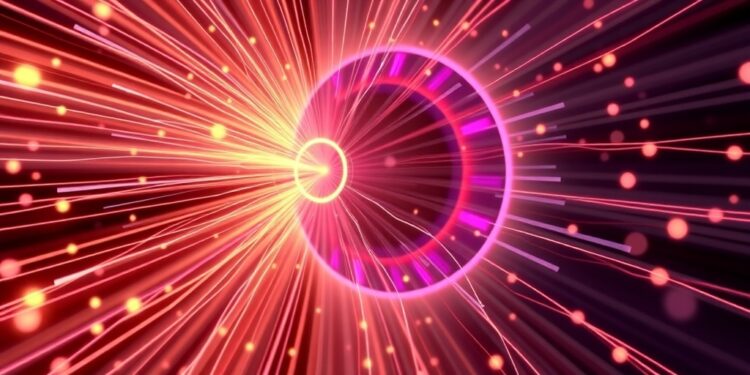
Electrons, the lightest and most mobile constituents of atoms, engage in rapid oscillatory behavior in the vicinity of a nucleus. Their movement occurs on the order of attoseconds, a timescale so brief that it renders direct observation nearly impossible. The typical challenge that scientists face is the daunting limitation of current observational technologies, which often cannot capture such fleeting events. However, in a groundbreaking study, researchers from UC San Diego’s Department of Chemistry and Biochemistry have unveiled a promising technique that aims to change this narrative and offers a fresh perspective on the study of electron dynamics.
This innovative method, referred to as ultrafast vortex electron diffraction, represents a significant advancement in the field of quantum mechanics. It allows researchers to visualize electron movement at astonishingly short timescales, specifically in the realm of attoseconds. The brilliance of this approach lies in its ability to harness specialized electron beams which exhibit a spiral motion while they travel. This unique spiraling trajectory facilitates an unprecedented level of precision when tracking the motions of electrons, both in spatial dimensions and temporal sequences.
A crucial aspect of the ultrafast vortex electron diffraction technique is its heightened sensitivity to electronic coherence. Coherent electron systems are characterized by their synchronous movement, echoing a harmonious dance that influences their collective behavior. By isolating these coherent dynamics from surrounding disturbances, scientists can delve deeper into the quantum processes prevalent in various materials, enhancing their understanding of energy transfer mechanisms and electron interactions within complex systems.
The implications of this research stretch far beyond mere observation. By elucidating how electrons behave in synchronized patterns, scientists can unlock new pathways to controlling chemical reactions. This aspect of the research resonates deeply with the ongoing quest to steer chemical processes at their most fundamental levels, offering potential applications in catalysis, materials science, and nanotechnology. The concept of manipulating electron dynamics provides a tantalizing glimpse into a future where scientists could optimize reactions intentionally and with remarkable precision.
The study was spearheaded by esteemed researchers Haowei Wu and Haiwang Yong, who delve into the complexities of electron behavior and its underlying mechanisms. Their work not only confronts the challenges of traditional observational methods but also opens doors to new experimental paradigms within the realm of physical chemistry and biochemistry. Supported by the W. M. Keck Foundation, this venture exemplifies the confluence of advanced technology and theoretical exploration, poised to reshape our understanding of molecular interactions.
What sets this technique apart is its potential to observe not just static images of electron arrangements but dynamic processes that unfold in real-time. This breakthrough could transform the fundamental ways in which researchers approach problems in quantum mechanics and material science. Ultrafast vortex electron diffraction heralds an era where transient phenomena that were once relegated to mere theory could be captured and studied comprehensively.
In their publication in the esteemed journal Physical Review Letters, Wu and Yong articulate their findings with clarity, elucidating the challenges faced in observing coherent electron behavior. By employing vortex electron beams, their methodology marks a departure from conventional approaches, setting a new benchmark for future research endeavors in this field. Their findings represent not only an academic triumph but also a critical step toward achieving a deeper understanding of the quantum world.
As the scientific community continues to grapple with the nuances of quantum dynamics, the implications of this research ripple outward, impacting a myriad of fields. From developing advanced quantum computing systems to innovating energy-efficient materials, the capacity to visualize and manipulate electron behavior offers potential solutions to pressing technological challenges. This work is timely and necessary amidst a global push for sustainable advancements in technology and materials.
The researchers’ enthusiasm for their findings is palpable, with Yong expressing the profound significance of their work. He states that this innovative technique brings them closer to the elusive goal of controlling chemical reactions at an atomic level. The ramifications of this control extend beyond theoretical constructs, ushering in a practical approach to understanding and manipulating the delicate intricacies of atomic interactions.
The publication and dissemination of this research generate considerable excitement within the scientific community and beyond. As researchers delve into the practical applications of ultrafast vortex electron diffraction, the potential for real-world applications becomes increasingly evident. The world may be on the brink of a quantum revolution, where harnessing the dynamics of electrons could pave the way for innovations previously thought unattainable.
In summary, the groundbreaking work of Haowei Wu, Haiwang Yong, and their team at UC San Diego represents not just a pivotal technological advancement but a comprehensive shift in our understanding of electron dynamics. By forging new pathways to observe and control electrons under exceedingly short timescales, they challenge established paradigms and urge us to reconsider how we interact with the atomic world.
As the study continues to inspire further research and inquiry, it serves as a reminder of the beauty and complexity inherent in the quantum realm. The adventures of electrons, once invisible to us, may soon become an intriguing spectacle of nature that scientists can observe, study, and ultimately manipulate. The quest for understanding the quantum world thus continues, with new horizons beckoning on the horizon.
Subject of Research: Visualization of Electron Motion in Molecules
Article Title: Diffractive Imaging of Transient Electronic Coherences in Molecules with Electron Vortices
News Publication Date: February 19, 2025
Web References: http://dx.doi.org/10.1103/PhysRevLett.134.073001
References: Physical Review Letters
Image Credits: UC San Diego
Keywords
Quantum mechanics, Electrons, Electronic coherence, Ultrafast vortex electron diffraction
Tags: attosecond timescale electron dynamicsbreakthroughs in observational technologyelectronic coherence sensitivityhigh-precision electron trackinginnovative techniques in physicsquantum mechanics advancementsrapid electron oscillatory behaviorreal-time electron movement visualizationspecialized spiraling electron beamsUC San Diego chemistry researchultrafast vortex electron diffraction techniqueunderstanding electron movement in atoms





